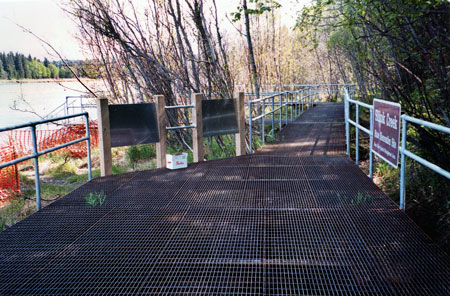Streambank Revegetation and Protection: A Guide for Alaska
Protection Techniques: Elevated Walkways
Elevated, light-penetrating walkways are a protection technique that provide access while protecting riparian habitat. Walkways should be constructed in a manner that allows riverbank vegetation to grow less unimpeded. Please contact a revegetation specialist for site-specific information.
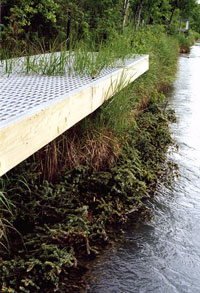
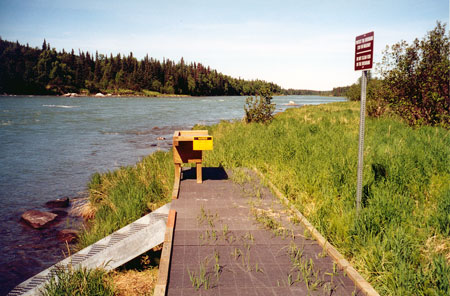
Materials: Walkways may be constructed using a variety of materials; including expanded and extruded metal, fiberglass, and wood.
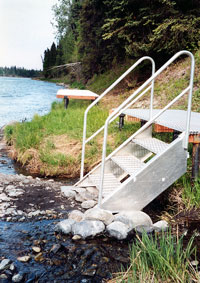
Construct walkways to protect the integrity of the existing riverbank. If it is necessary to drive posts into the bank for walkway support, care should be taken to avoid placing posts too close to the edge of the bank to prevent bank destabilization. Walkways can be placed on above ground supports, such as the tripod. Design of walkways should conform to all state, federal and local applicable building codes. A Kenai Peninsula Borough Chapter 21.18 permit is required to construct elevated light penetrating structures such as walkways, stairs and ramps. The structures can be built with at least 60 percent light penetration, no wider than eight feet in width and must be constructed so that no part, other than the supporting posts, is closer than four inches from the ground. Or the structure can be built with less than 60 percent but a minimum of 25 percent light penetration, no wider than six feet in width and must be constructed so that no part, other than the supporting posts, are less than 18 inches from the ground(Kenai Peninsula Borough Ordinance Chapter 21.18).
- Stairs or ladders can easily be attached to elevated, light-penetrating walkways to provide access into lakes or streams.
- Floating docks can be connected to walkways to provide boating access.
- Walkways can be cantilevered over a river. This will provide good fishing access while protecting riparian habitat.
- Walkway supports should be adjustable to compensate for settling.
- Walkways longer than 50 feet need to have wildlife breaks for safe passage. Avoid handrails when possible to reduce barriers to wildlife movement. If seasonal handrails are installed, remove after each season to reduce animal barriers.
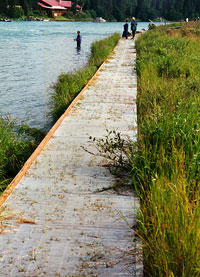
Advantages:
- Keeps people off vegetation - allows native vegetation to grow
- Provides access and directs people to recreational sites
- Protects investment - streambank and restoration work
- Prevents trampling and erosion of vegetation
- Protects fish and wildlife habitat
Disadvantages:
- Moderately expensive
- Maintenance is required
- Certain portions may need to be seasonally removed
- Drilling pipe for walkways may be difficult and risks destabilizing banks, may require heavy machinery
- Aesthetics - not natural structure
